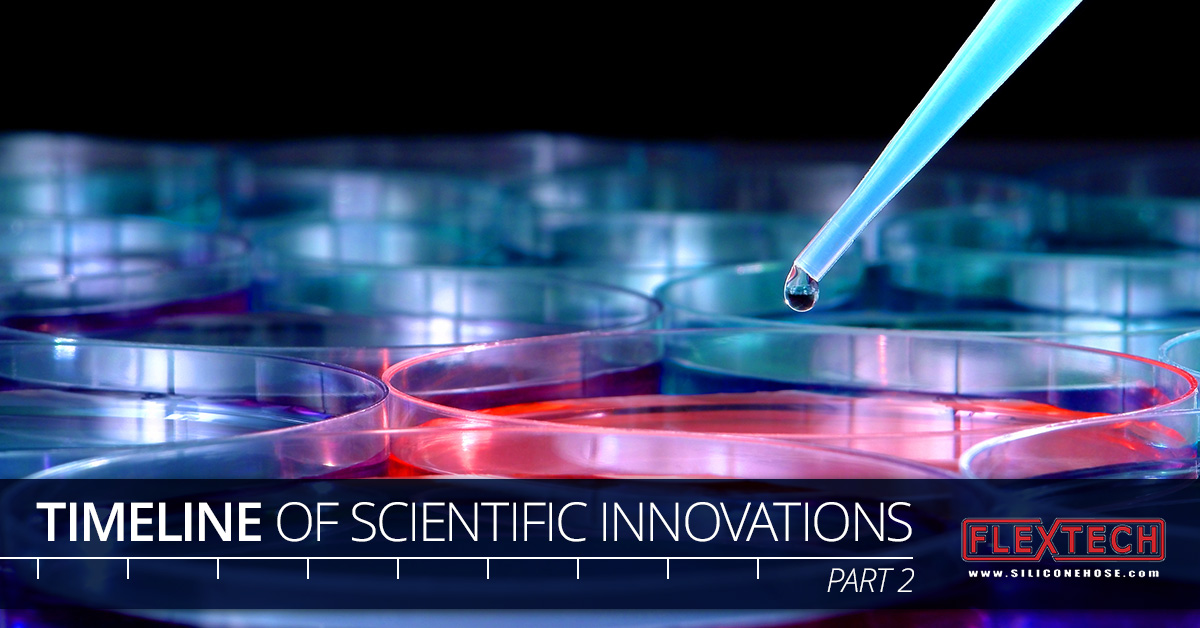
Here at Flex Technologies, we are proud to be on the cutting edge of industrial silicone tube and hose manufacturing innovation. Our commitment to improvement is how we are able to offer such high quality silicone products at such a great price, and why they see use in every industry from medical, to agriculture, to aerospace. We understand that we are standing on the shoulders of giants though, relying on past innovations for ever more complex processes. In honor of all of the innovators before us, here is a quick timeline of scientific innovations.
14th to 16th Centuries
The Islamic enlightenment period ended around the 14th century. European enlightenment would not reach its peak until the 18th century. However, that does not mean that the period in between was devoid of any scientific innovations. This Late Middle Age also saw plenty of improvement in a wide range of fields.
- It was in the early 14th century that the famous William of Ockham came up with Occam's Razor. Occam's Razor is a principle of problem solving wherein the simplest answer (the one that makes the least assumptions) is the correct one.
- Before the concepts of inertia, momentum, and acceleration in classical mechanics came to be established science, Jean Buridan created the theory of impetus in the early 14th century. It explained things like projectile motion in relation to gravity.
- Later in the 14th century, Nicole Oresme, a French philosopher, was the first person to record and discover atmospheric refraction of light in relation to the curvature of the earth.
- At the very end of the 15th century, one Luca Pacioli created the first ever double-entry book keeping system, wherein ledgers had a credit and debit line to better keep track of the storage of items.
- In the middle of the 16th century, Nicolas Copernicus took the world full circle, bringing us back to the heliocentric model first discovered by Aristarchus. Before that, the Church had promoted a geocentric model in line with the tenets of the Bible.
- Right at the end of the 16h century, a researcher named William Gilbert made huge strides in the field of electromagnetism. Not only did he raise awareness of Earth's magnetic field, but he also created the first electric measurement instruments. He also helped to popularize the word "electricity".
17th and 18th Centuries
These two centuries marked a a major change in thinking. The European Enlightenment period would come into its own, with huge strides being made by nations in technological innovation. It was a huge information boom, and we discovered much of the science that even modern society functions on.
- Perhaps one of the most metaphorically significant scientific innovations of the time was the invention of the telescope, ostensibly by an eyeglass maker in the Netherlands named Hans Lippershey. This was right at the beginning of the 16th century. Hans failed to get a patent on his telescope, which still gained popularity across the known world. Not even a decade later, Johannes Kepler would improve on Lippershey's design using convex objective lenses and convex eyepiece lenses.
- Also in the beginning of the 17th century, Johannes Kepler would codify the first two laws of planetary motion. The first one states that an orbit of a planet will be in the form of an eclipse, with the Sun acting as one of two foci. The second states that that any imaginary line connecting a planet and the Sun (one of the two foci) will cover an equal area over an equal interval of time.
- In 1614, John Napier introduced logarithms into mathematics as a way to simplify calculations. Logarithms are essentially the opposite operation of an exponent operation, like division is the opposite operation of multiplication. A logarithm of a number is an exponent of another number, the base, which must be multiplied by its own value by the number of exponents to reach the number.
- Later in the century, in the year 1619, Johannes Keppler would again make great strides in scientific innovation with his third law of planetary motion, which goes over the proportional relation between the square of an orbital period and the cube of the semi-major axis of its orbit.
- In 1628, WIlliam Harvey would make great strides in the theory of blood circulation. Before Harvey, there was no link between veins and arteries, and the circulatory system was thought to move blood only to the lungs. Harvey was the first person to propose that the heart pumped blood all through the body all the time, even the extremities.
- Evangelista Torricelli invented a mercury barometer in 1643. A barometer is an instrument that measures air pressure, and using mercury allowed for more accuracy than previous barometers could measure.
- In 1665, a huge discovery was made in the fields of biology and chemistry when Robert Hooke first mapped the human cell. He named them after the cells in which Christian Monks used to inhabit, which they resembled under his microscope.
- Before Nicholas Steno in 1669, the common belief of the time was that fossils grew in the ground. Steno was the first person to argue that fossils are actually the remains of organic lifeforms, a discovery which also laid the groundwork for stratigraphy.
- In 1675, Anton van Leeuwenhoek would become the first person to observe microorganisms directly under a microscope. This laid the groundwork for germ theory much later.
- In 1687, Sir Isaac Newton would lay the groundwork for modern physics (barring quantum mechanics and special relativity) with his classical description of the fundamental force in mathematics of universal gravitation. He would also come up with the three physical laws of motion.
- In astronomy, Mikhail Lomonosov made great strides with the discovery of an atmosphere on the planet Venus. Surprisingly, he did not observe the atmosphere directly with a telescope, but rather posited it based on an observation of its transit.
- Infrared radiation was discovered in the year 1800 by one William Herschel. Infrared light is light in the red color of the spectrum, and measures anywhere between 700 nano meters to one millimeter in length.
We hope you enjoyed this timeline of scientific innovations. Stay tuned for Part 3 in our series. Here at Flex Technologies, we are proud to be on the cutting edge of industrial silicone tubes and hose manufacturing innovation. For more information on our online silicone products, please do not hesitate to give us a call at your earliest convenience.
 Default Currency
Default Currency
 Mexican Pesos
Mexican Pesos
 Canadian Dollar
Canadian Dollar


